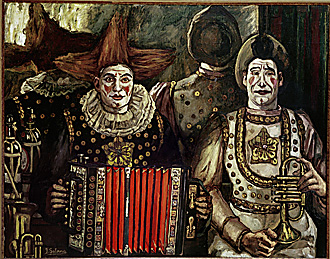The Clowns - 1919
Museo Centro de Arte Reina Dona Sofia - Madrid - Spain
José Gutiérrez Solana (1886-1945) was born in Madrid, where he spend much of his life, and his work reflects both the asthetic qualities of the Spain he experienced from day to day and his concept of the character of the times. As a young man, he spent his days in the slums and suburbs of Madrid and in the Cantabrian harbours, studying the most wretched aspects of Spanish life. These journeys were the basis for his gloomy and corrosive literary works, Scenes and Customs of Madrid, 2 vol. (1912, 1918), and for his intense and dramatic paintings. He started his artistic training in 1893, taking private lessons before entering the Real Academia de Bellas Artes de San Fernando, in Madrid, in 1900.
In 1904 Solana became involved with the Generation of 1989 movement - a group of writers and philosophers attempting to re-create Spain as an intellectual and literary leader in response to the sociopolitical disaster of its defeat in the 1898 Spanish-American War. Solana's paintings and writing reflect the group's somber, ironic attitude, and throughout his career his work remained largely melancholic.
The clown figures can be seen here with a mirror behind. Maybe by showing their back on the mirror, Solana is telling the viewer that all clowns wear a mask and by looking closely their performances we understand that there's an hidden man inside, different, storng or fail, we'll never know. The two clowns look like fragil figures, specially the one on the right. Both are trying to express themselves with a visible overwhelming effort and, for their faces, it looks like the audience is not much focuses on their performances. Both, do not show a confident pose, although the one with the accordion is evidently performing with his maximum involvement and commitment, surely expecting to captivate his audience attention. This Vaudeville performance has an athmosfere steeped into both tragic and comic and for some reason we get the perception that it'll not leave any good rememberence neither in the audience nor, surely, for both clows. In a way, the viewer ends up being pity for the unconfortable pose of the men wishing that their struggling performance ends up as soon as possible. Solana, expresses here the performance of anguished and tortured souls, when men act in unatural ways and at the end suffer beneeth their masks. Staring impassively with a disquieting detachment, Solana's clowns evoke neither sympathy nor fear, but a polarity of menace and tragedy. Drawn in a precisely linear manner and colored with the subdued palette that was typical of his work, the two clowns border on the mechanical, which further emphasizes the surreal quality of the painting.
The clown theme was adopted by several artists of the era as the ultimate parody - the tragic hero defined by the comic mask of his existence, and there was an identification between artists and the clown in the struggle for their art in the face of modern criticism. Solana was greatly influenced by fellow artists and countrymen Juan de Váldes Leal (1622-90) and Francisco Goya 1746-1828).
Source: Wikipedia, Tamsin Pickeral, net

1 comentário:
Learn how to buy Solana with Bitcoin easily and securely. Discover the best platforms, step-by-step instructions, fees, and wallet tips in this updated 2025 guide.
Enviar um comentário